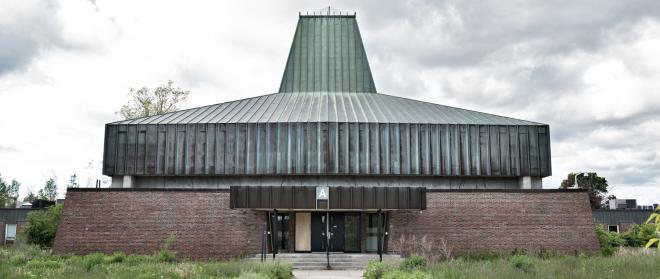
Lundi le 25 avril 2022
PATRIMOINE OTTAWA
Mise à jour
Patrimoine Ottawa a participé dans un webinaire et une discussion organisé par la Société immobilière du Canada sur le concept préférentiel proposé pour réintégrer le site du 1495, chemin Heron dans la collectivité. L'option préférentiel propose la réhabilitation des bâtiments patrimoniaux existants pour une réutilisation adaptative qui comprend une nouvelle école et des unités d'habitation de hauteur moyenne.
Nous appuyons le maintien des bâtiments patrimoniaux existants et attendons avec impatience de voir un plan plus détaillé à la fin du printemps.
Un compte-rendu sommaire et une vidéo sont disponibles ICI. Vous pouvez partager vos commentaires jusqu'au 29 avril.
Background
In July, 2020 the Canada Lands Company (CLC), a federal crown corporation that specializes in real estate and development, acquired a 21-acre property from Public Services and Procurement Canada located at 1495 Heron Road adjacent to the Guildwood Estates in Alta Vista to facilitate its sale. The government operated the Federal Study Centre there for 40 years until 2014 when it was declared surplus. The site has been vacant ever since.
A Modernist Educational Complex
The complex of educational buildings that make up the site was constructed in 1965 as the new Campanile Campus of the Notre Dame Convent. The complex was designed by the prominent Ottawa firm of Murray & Murray, architects and urban planners, for the Sisters of the Congregation of Notre Dame (a religious order founded in 1658) as a modern educational campus using high quality materials and craftsmanship.
The complex included a dozen interconnected pavilions identified by their dark, rough brick surfaces and by their careful organization around four small courtyards with a chapel at its core. Among the buildings were a theatre, gymnasium, and cafeteria, all connected by glassed walkways and underground tunnels.
The chapel, known as pavilion A, is the anchor of the complex and was given a distinctive architectural profile defined by sloping walls, limited window openings, and a massive, truncated, offset pyramidal copper roof.
Due to financial pressures, the nuns sold the complex to the federal government in 1974.
Federal Heritage Designation
In 2005, the modernist Campanile Campus/Federal Study Centre was designated as a Recognized heritage site by the Federal Heritage Buildings Review Office (FHBRO) for its “architectural and environmental values, as well as its historical associations.” FHBRO prepared Heritage Character Statement reports for the pavilions and their relationship to the complex as a whole, which is described as a “self-contained environment” where buildings and exterior spaces interconnect with the use of plantings, walkways and brick screen walls, creating “zones of intimacy“ that give a “human scale to this ‘total design’”.
Heritage Ottawa Sends Feedback
In March 2021, Canada Lands Company (CLC) launched a community engagement program for the property with the goal of developing a new vision for the site that could include some type of adaptive reuse which would result in its sale for private development. (The deadline for submitting comments ended April 30).
Knowing that FHBRO designations no longer apply to properties that are sold to the private sector, Heritage Ottawa emphasized preservation and protection of all or part of the property in its feedback to the CLC. Here is a summary of that submission:
- Primary goal should be to explore the use of the existing buildings with modifications for residential, institutional, recreational and/or retail uses.
- Interpret the significance of the Sisters of Notre Dame with the site and the order's contribution to Canadian society in the National Capital Region.
- Seek heritage designation for some of the buildings (e.g. the chapel, auditorium, etc.) based on FHBRO research and analysis as being excellent examples of modern architecture as reflected in education/learning uses.
- Use the CLC’s approach to the Booth Street complex of buildings as a model in recommending a blend of preservation and adaptive reuse. In this instance, Canada Lands, in conjunction with the community and City, identified specific buildings for designation within a concept plan for the entire property.
- In terms of density, priority should be given to providing a significant block of affordable housing within the current physical parameters.
- Retail components should exist to support the current and redeveloped portions of the Guildwood Estates neighbourhood, rather than being a specific goal of the redevelopment.
Heritage Ottawa has contacted the City’s Heritage Planning Section to determine whether there are any plans to seek heritage designation under the Ontario Heritage Act for all or any part of the property. We also participated in a February Workshop for input into future redevelopment plans for the site.
Heritage Ottawa is also providing support to the Guildwood Estates Community Association, which is very concerned about protection of the integrity of the site and any future development.
Next Steps - CLC Master Plan
In April, 2022 the CLC announced plans to develop a master plan that will outline how the available land will be used, what buildings will be built or removed, heritage and commemoration elements, servicing and infrastructure, as well as guidelines for architectural and landscape design, and the inclusion of public spaces and amenities for the broader community. We will report back when we learn more.
Related Reading:
Campanile Church in Alta Vista now sits like a Ghost Town, its Future Uncertain | Ottawa Magazine, October 4, 2017
Federal Study Centre to be Transferred to Canada Lands | Heritage Ottawa, January 22, 2015
